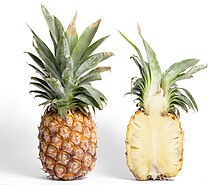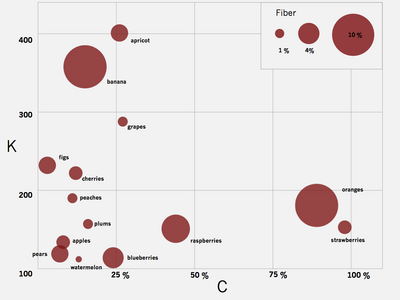Table of fleshy fruit examples
| Type | Examples |
|---|---|
| Simple fleshy fruit | True berry, stone fruit, pome |
| Aggregate fruit | Boysenberry, lilium, magnolia, raspberry, pawpaw, blackberry, strawberry |
| Multiple fruit | Fig, osage orange, mulberry, pineapple |
| True berry | Banana, blackcurrant, blueberry, chili pepper, cranberry, eggplant, gooseberry, grape, guava, kiwifruit, lucuma, pomegranate, redcurrant, tomato, watermelon |
| True berry: Pepo | Cucumber, gourd, melon, pumpkin |
| True berry: Hesperidium | Grapefruit, lemon, lime, orange |
| Accessory fruit | Apple, rose hip, stone fruit, pineapple, blackberry, strawberry |
Seedless fruits
 The fruit of a pineapple includes tissue from the sepals as well as the pistils of many flowers. It is a multiple-accessory fruit.
The fruit of a pineapple includes tissue from the sepals as well as the pistils of many flowers. It is a multiple-accessory fruit. Seedlessness is an important feature of some fruits of commerce. Commercial cultivars of bananas and pineapples are examples of seedless fruits. Some cultivars of citrus fruits (especially grapefruit, mandarin oranges, navel oranges), satsumas, table grapes, and of watermelons are valued for their seedlessness. In some species, seedlessness is the result of parthenocarpy, where fruits set without fertilization. Parthenocarpic fruit-set may (or may not) require pollination, but most seedless citrus fruits require a stimulus from pollination to produce fruit.[28] Seedless bananas and grapes are triploids, and seedlessness results from the abortion of the embryonic plant that is produced by fertilization, a phenomenon known as stenospermocarpy, which requires normal pollination and fertilization.[29]
Seed dissemination
Variations in fruit structures largely depend on the modes of dispersal applied to their seeds. Dispersal is achieved by wind or water, by explosive dehiscence, and by interactions with animals.[30]
Some fruits present their outer skins or shells coated with spikes or hooked burrs; these evolved either to deter would-be foragers from feeding on them or to serve to attach themselves to the hair, feathers, legs, or clothing of animals, thereby using them as dispersal agents. These plants are termed zoochorous; common examples include cocklebur, unicorn plant, and beggarticks (or Spanish needle).[31][32]
By developments of mutual evolution, the fleshy produce of fruits typically appeals to hungry animals, such that the seeds contained within are taken in, carried away, and later deposited (i.e., defecated) at a distance from the parent plant. Likewise, the nutritious, oily kernels of nuts typically motivate birds and squirrels to hoard them, burying them in soil to retrieve later during the winter of scarcity; thereby, uneaten seeds are sown effectively under natural conditions to germinate and grow a new plant some distance away from the parent.[4]
Other fruits have evolved flattened and elongated wings or helicopter-like blades, e.g., elm, maple, and tuliptree. This mechanism increases dispersal distance away from the parent via wind. Other wind-dispersed fruit have tiny "parachutes", e.g., dandelion, milkweed, salsify.[30]
Coconut fruits can float thousands of miles in the ocean, thereby spreading their seeds. Other fruits that can disperse via water are nipa palm and screw pine.[30]
Some fruits have evolved propulsive mechanisms that fling seeds substantial distances – perhaps up to 100 m (330 ft) in the case of the sandbox tree – via explosive dehiscence or other such mechanisms (see impatiens and squirting cucumber).[33]
Food uses
 Picking blackberries in Oklahoma
Picking blackberries in OklahomaA cornucopia of fruits – fleshy (simple) fruits from apples to berries to watermelon; dry (simple) fruits including beans and rice and coconuts; aggregate fruits including strawberries, raspberries, blackberries, pawpaw; and multiple fruits such as pineapple, fig, mulberries – are commercially valuable as human food. They are eaten both fresh and as jams, marmalade and other fruit preserves. They are used extensively in manufactured and processed foods (cakes, cookies, baked goods, flavorings, ice cream, yogurt, canned vegetables, frozen vegetables and meals) and beverages such as fruit juices and alcoholic beverages (brandy, fruit beer, wine).[34] Spices like vanilla, black pepper, paprika, and allspice are derived from berries. Olive fruit is pressed for olive oil and similar processing is applied to other oil-bearing fruits and vegetables.[35] Some fruits are available all year round, while others (such as blackberries and apricots in the UK) are subject to seasonal availability.[36]
Fruits are also used for socializing and gift-giving in the form of fruit baskets and fruit bouquets.[37][38]
Typically, many botanical fruits – "vegetables" in culinary parlance – (including tomato, green beans, leaf greens, bell pepper, cucumber, eggplant, okra, pumpkin, squash, zucchini) are bought and sold daily in fresh produce markets and greengroceries and carried back to kitchens, at home or restaurant, for preparation of meals.[39]
Storage
All fruits benefit from proper post-harvest care, and in many fruits, the plant hormone ethylene causes ripening. Therefore, maintaining most fruits in an efficient cold chain is optimal for post-harvest storage, with the aim of extending and ensuring shelf life.[40]
Nutritional value
 Comparing fresh fruits for fiber, potassium (K), and vitamin C.[citation needed] Each disk-point refers to a 100 g (3.5 oz) serving of the fresh fruit named. The size of the disk represents the amount of fiber (as percentage of the recommended daily allowance, RDA) in a serving of fruit (see key at upper right). The amount of vitamin C (as percent RDA) is plotted on the x–axis and the amount of potassium (K), in mg on the y–axis. Bananas are high in value for fiber and potassium, and oranges for fiber and vitamin C. (Apricots are highest in potassium; strawberries are rich in vitamin C.) Watermelon, providing low levels of both K and vitamin C and almost no fiber, is of least value for the three nutrients together.
Comparing fresh fruits for fiber, potassium (K), and vitamin C.[citation needed] Each disk-point refers to a 100 g (3.5 oz) serving of the fresh fruit named. The size of the disk represents the amount of fiber (as percentage of the recommended daily allowance, RDA) in a serving of fruit (see key at upper right). The amount of vitamin C (as percent RDA) is plotted on the x–axis and the amount of potassium (K), in mg on the y–axis. Bananas are high in value for fiber and potassium, and oranges for fiber and vitamin C. (Apricots are highest in potassium; strawberries are rich in vitamin C.) Watermelon, providing low levels of both K and vitamin C and almost no fiber, is of least value for the three nutrients together. Various culinary fruits provide significant amounts of fiber and water, and many are generally high in vitamin C.[41] An overview of numerous studies showed that fruits (e.g., whole apples or whole oranges) are satisfying (filling) by simply eating and chewing them.[42]
The dietary fiber consumed in eating fruit promotes satiety, and may help to control body weight and aid reduction of blood cholesterol, a risk factor for cardiovascular diseases.[43] Fruit consumption is under preliminary research for the potential to improve nutrition and affect chronic diseases.[44][45] Regular consumption of fruit is generally associated with reduced risks of several diseases and functional declines associated with aging.[46][47][48]
Food safety
For food safety, the CDC recommends proper fruit handling and preparation to reduce the risk of food contamination and foodborne illness. Fresh fruits and vegetables should be carefully selected; at the store, they should not be damaged or bruised; and precut pieces should be refrigerated or surrounded by ice.
All fruits and vegetables should be rinsed before eating. This recommendation also applies to produce with rinds or skins that are not eaten. It should be done just before preparing or eating to avoid premature spoilage.
Fruits and vegetables should be kept separate from raw foods like meat, poultry, and seafood, as well as from utensils that have come in contact with raw foods. Fruits and vegetables that are not going to be cooked should be thrown away if they have touched raw meat, poultry, seafood, or eggs.
All cut, peeled, or cooked fruits and vegetables should be refrigerated within two hours. After a certain time, harmful bacteria may grow on them and increase the risk of foodborne illness.[49]
Allergies
Fruit allergies make up about 10 percent of all food-related allergies.[50][51]
You received this message because you are subscribed to the Google Groups "1top-oldtattoo-1" group.
To unsubscribe from this group and stop receiving emails from it, send an email to 1top-oldtattoo-1+unsubscribe@googlegroups.com.
To view this discussion on the web visit https://groups.google.com/d/msgid/1top-oldtattoo-1/CAGNPKmm4NWKt2CTz-nvCKrOWwh0PbMFEubrWYS5R5jzZa7HYKg%40mail.gmail.com.
No comments:
Post a Comment